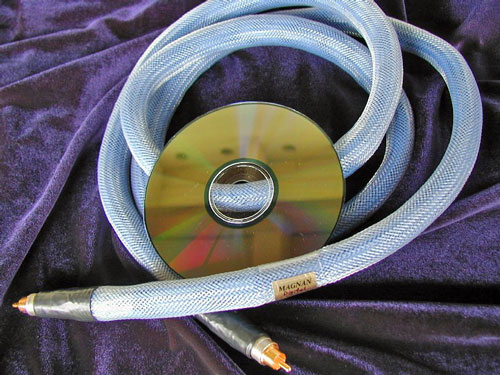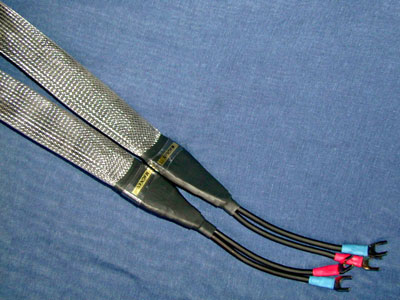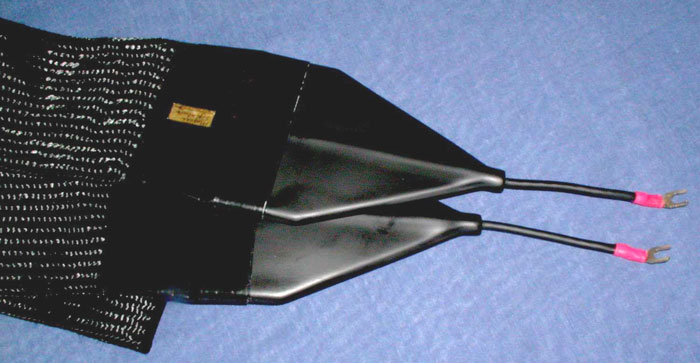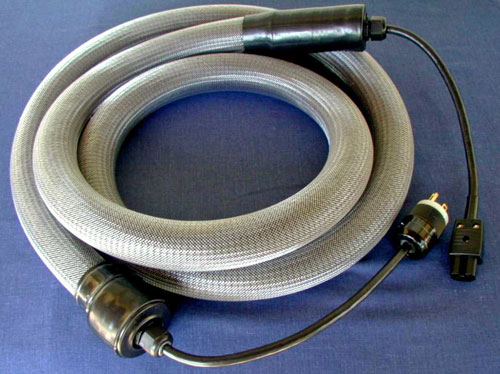Introduction
Would you pay good money for a speaker cable that imparts almost no sonic signature of its own? In other words, would you pay more to obtain seemingly less if it allowed you to enjoy the music more? You might answer, “That all depends…” Indeed, as I assessed the value and sound character of Magnan Cables, my judgment of them depended upon whether excellent sound could be achieved with a design goal emphasizing ultra- diminutive conductors.
Welcome to the “flat” world of Magnan Audio Cables. No, not Magnepan, but Magnan, named after David Magnan, an electronics engineer and programmer who has spent time as a civilian working for the Navy on projects, such as digital fire control and avionics for aircraft like the F-14 Tomcat. As an avid fan of classical music and Jazz, David has thrusted himself into the rarified air of audiophile cable design.
The result has been a flat – no, I mean flat as in micro-thin flat – cable designed to counter “skin effect” and time smearing. Having tested numerous conventional cable designs, all without satisfaction, David began flattening and thinning the conductor as a way to reduce skin effect. Just what is skin effect? According to David, it is essentially a change in the electric field around the conductor which causes the signal current corresponding to a sound to be “stretched out in time”. As the high frequencies arrive earlier than the lower frequencies, a phenomenon called “time smearing” occur. David states that it results in, “blurring and flattening of soundstage, smearing together of instrumental images, muddiness…and usually a general overbrightness.”
Details Of Flatness
Magnan’s claim to fame is reduction of “skin effect.” I’ve seen a few women whose makeup is so thick they could use a bit of skin effect, as in scraping off enough goop to actually see skin! In a technological breakthrough for makeup, Bare Essentials sells powdered rock which is applied in a very thin layer. The results certainly are fabulous on my lovely wife Connie’s face! There is no “goop layer” to mess up her looks, only the super thin coloration which allows her skin to be seen as mildly tinted, a very nice result. I never dreamed I’d be discussing makeup in a cable review. In similar fashion, David seems to be removing the “goop layer” of time smear by not giving the conductor enough room for it to be caked onto the signal.
In order to achieve this, David had to reduce the gauge of the conductor radically. According to David, it results in “a sort of sonic rightness and clarity with outstanding transparency and coherence of sonic image without any HF edge.” As stated early on, the conductors are intentionally reduced as much as possible. Hidden behind lovely silver and black woven braided nylon jackets, shockingly thin copper highways lay embedded in an air space/TFE Teflon dielectric. (Note that different models employ different conductors, including bronze and a silver/bronze combination; see the website for details). How thin are we talking? Before I answer, allow me to share David’s answer to the question I posed regarding the gauge of the cables: If a primary goal is the reduction of skin effect, couldn’t a person take multiple, very small gauge wires and create a woven cable with low skin effect?
After all, if the goal is smaller gauge, then why not make something akin to the CAT-5 DIY cables which some have suggested are so good? I should have known, David had a very good answer. He had already conducted tests with thin – I mean vanishingly thin wires (are you detecting a pattern here?) – in order to achieve significant reduction in skin effect. He had to make them so small that they were impossibly delicate. How, then, could he achieve his goal in making skin effect go away without making the conductor go away? By putting lots of micro-thin conductors really close together, in other words a super thin sheet.
The result is an extremely flat but wide cable. How thin are the conductive sheets? In the Signature speaker cable, which is 5” wide, the actual conductor is .00075” thick! That’s 7.5/10,000 thick, or shall I say thin? The Type VI interconnect is a coaxial design with .0005” (by the way, this is much thinner than a human hair) bronze conductor in an 80% air and 20% Teflon dielectric. A person doesn’t need a blowtorch to cut through these wires. I wonder how many could be stacked and still cut with a scissors? Maybe I’ll ask Dave on a successive review.
Not That Flat
It wasn’t difficult to come up with the question, “Will I destroy one of these if I step on it?” After all, I’ve put my foot through things a lot thicker than .0005” of metal! What good is a cable if one fold or one misstep is disaster? David reassured me that they are quite durable and a step on them will not harm them. I confirmed this with my own experience, since I accidentally stepped on one while hooking them up. It kept working, so I bent it over and began jumping on it. NO, just kidding! But, the Signature speaker cables arrived neatly folded, complete with creases in them. They stretched out nicely, and the nylon outer jacket bounced back to normal form quickly. From my experience, conscientious handling of them will not harm them. I did not have to be too concerned in handling them, however one should take care not to snag the somewhat loose nylon woven jacket lest a pull occurs. Working the pull with fingers can shrink it back into the weave.
Just how does one get an ultra thin 5” wide sheet to merge with a single-ended connector? Very carefully! Although that construction method remains a secret, one sees each Signature speaker conductor (all four are separate cables; two positive and two negative cables constitute one pair) at its end has an appropriately flat, triangular shaped reducing collar to shunt the body of the conductor toward a more conventional looking lead. Terminations are typically rhodium-plated spade or banana.
There are so many things in audio which, at first blush, seem counter-intuitive, yet work. One is polishing CD’s. I do not consider it to be a tweak, since it is needed only once and the results are permanent, even more so than cleaning an album. Intuitively, one would think that no sonic benefit would result from polishing a CD, yet one would be seriously wrong (Whether one prefers the result is completely an individual decision). I thoroughly enjoy taking a visitor’s untreated disc, setting a listening baseline, then treating it and replaying. The last time I did so, my acquaintance exclaimed, “WOW,” on the order of six times. What seems unlikely can rapidly become unimaginable to live without. He proceeded to polish his entire collection of discs – some 1,000 plus of them.
Quickly: Fat Flat, “Phat”
“… remember, we’re dealing with electron flow in cables, not water flow …”
So it is with extremely flat cables. Intuitively one would think that a round “pipeline” construction would most benefit the sound. After all, in many engineering applications round pipelines are the ideal. The mind naturally connects the image of a flattened cable with flat or restricted sound. But remember, we’re dealing with electron flow in cables, not water flow. In a garden hose, a flat cable isn’t too advantageous, but in copper conductors it’s no impediment at all. The ability of manufacturers to shape the conductor of a cable into whatever shape they desire can result in lovely sonic benefits. That is what I propose Magnan Cables to be, lovely flat things with a phat (That’s Pretty Hot And Tempting) sound. You’ve heard the term PRAT? Magnan cables are PHAT!
I have been going on for some time about how flat Magnan cables are, but there is a surprise in store! Certain models are not just flat, but downright fat (No, not phat, normal fat)! Magnan cables are actually both flat and fat, two radically different looks from one manufacturer. The Reference speaker cable is not as extremely wide as the Signature; it has the same thinness of conductor at 1 ¼” wide, and has both leads stacked within a single silver nylon braided jacket. The Type Vi, Silver-Bronze interconnects and the Magnan Digital are the only conventional looking cables Magnan offers. Dave Magnan has a thing for skinny wires in his IC’s too, these being .0005” thick Type Vi arranged in a coaxial configuration. The diameter of both the RCA and XLR interconnects is approximately ½”.
The inverse of the Signature speaker cables, the Signature power cables, are an exercise in size! They dwarf most other power cables, and with their bulk and light grey hue, remind me of elephant trunks! Thankfully, similar to elephant trunks, they are flexible for their size. They also utilize the super-flat copper conductors which are tapered down via custom collars to IEC terminations.
The power cables can cause an audiophile to do a double-take. They are very generously proportioned along their midsection, but at the ends taper quickly at the last foot to a modest tool shop power cord diameter. One might wonder, “Why the pretense? Why have six feet of an eight foot cord be outrageously large with one foot of smaller cable on each end?” The conclusion I came to is that Magnan Cables are flattened and thinned to whatever extent possible. Being such radically different conductors, they must at some point be melded to conventional leads or else they would not work with components. I’m sure that in an ideal world, David would insist on hooking up the flat conductors directly to the component. So, he has settled for turning as much of the conductor as possible into his super thin sheets.
- (Page 1 of 2)
- Next page →



